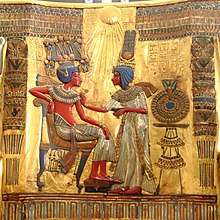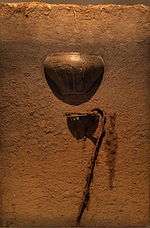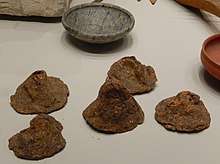Grave goods
Grave goods, in archaeology and anthropology, are the items buried along with the body.

They are usually personal possessions, supplies to smooth the deceased's journey into the afterlife or offerings to the gods. Grave goods may be classed as a type of votive deposit. Most grave goods recovered by archaeologists consist of inorganic objects such as pottery and stone and metal tools but organic objects that have since decayed were also placed in ancient tombs.[1] Funerary art is a broad term but generally means artworks made specifically to decorate a burial place, such as miniature models of possessions including slaves or servants for "use" in the afterlife.
Where grave goods appear, grave robbery is a potential problem. Etruscans would scratch the word śuθina, Etruscan for "from a tomb", on grave goods buried with the dead to discourage their reuse by the living.[2] The tomb of pharaoh Tutankhamun is famous because it was one of the few Egyptian tombs that was not thoroughly looted in ancient times.
Grave goods can be regarded as a sacrifice intended for the benefit of the deceased in the afterlife. Closely related are customs of ancestor worship and offerings to the dead, in modern western culture related to All Souls' Day (Day of the Dead), in East Asia the "hell bank note" and related customs. Also closely related is the custom of retainer sacrifice, where servants or wives of a deceased chieftain are interred with the body. As the inclusion of expensive grave goods and of slaves or retainers became a sign of high status in the Bronze Age, the prohibitive cost led to the development of "fake" grave goods, where artwork meant to depict grave goods or retainers is produced for the burial and deposited in the grave in place of the actual sacrifice.
History

There are disputed claims of intentional burial of Neanderthals as old as 130,000 years. Similar claims have been made for early anatomically modern humans as old as 100,000 years. The earliest undisputed cases of burials are found in modern human sites of the Upper Palaeolithic.
Beads made of basalt deposited in graves in the Fertile Crescent date to the end of the Upper Paleolithic, beginning in about the 12th to 11th millennium BC.[3]
The distribution of grave goods are a potential indicator of the social stratification of a society. Thus, early Neolithic graves tend to show equal distribution of goods, suggesting a more or less classless society, while in Chalcolithic and Bronze Age burials, rich grave goods are concentrated in "chieftain" graves (barrows), indicating social stratification.[4] It is also possible that burial goods indicate a level of concern and consciousness in regard to an afterlife and related sense of spirituality.
Famous grave sites

The expression of social status in rich graves is taken to extremes in the royal graves of the Bronze Age. In the Theban Necropolis in Ancient Egypt, the pyramids and the royal graves in the Valley of the Kings are among the most elaborate burials in human history. This trend is continued into the Iron Age. An example of an extremely rich royal grave of the Iron Age is the Terracotta Army of Qin Shi Huang.
In the sphere of the Roman Empire, early Christian graves lack grave goods, and grave goods tend to disappear with the decline of Greco-Roman polytheism in the 5th and 6th centuries. Similarly, the presence of grave goods in the Early Middle Ages in Europe has often been taken as evidence of paganism, although during the period of conversion in Anglo-Saxon England and the Frankish Empire (7th century), the situation may be more complicated.[5] In the Christian Middle Ages, high-status graves are marked on the exterior, with tomb effigies or expensive tomb stones rather than by the presence of grave goods.
The practice of placing grave goods with the dead body has thus an uninterrupted history beginning in the Upper Paleolithic, if not the Middle Paleolithic, upheld until comparatively recent times, in many regions of the world ceasing only with Christianization.
Role in archaeology
The importance of grave goods, from the simple behavioural and technical to the metaphysical, in archaeology cannot be overestimated. Because of their almost ubiquitous presence throughout the world and throughout prehistory, in many cases the excavation of every-day items placed in burials is the main source of such artifacts in a given prehistoric culture. However, care must be taken to avoid naive interpretation of grave goods as an objective sample of artifacts in use in a culture. Because of their ritual context, grave goods may represent a special class of artifacts, in some instances produced especially for burial. Artwork produced for the burial itself is known as funerary art, while grave goods in the narrow sense are items produced for actual use that are placed in the grave, but in practice the two categories overlap.
Grave goods in Bronze Age and Iron Age cemeteries are a good indicator of relative social status; in a 2001 study on an Iron Age cemetery in Pontecagnano Faiano, Italy, a correlation was found between the quality of grave goods and Forensic indicators on the skeletons, showing that skeletons in wealthy tombs tended to show substantially less evidence of biological stress during adulthood, with fewer broken bones or signs of hard labor.[6]
See also
- Burial
- Grave field
- Necropolis
- Mingqi, the traditional Chinese burial goods
References
- Ian Morris, Death-Ritual and Social Structure in Classical Antiquity (Cambridge, 1992; ISBN 0-521-37611-4)
- Giuliano Bonfante and Larissa Bonfante The Etruscan Language: an Introduction (Univ. Manchester Press, 2002. ISBN 0-7190-5540-7); several examples collected
- The Earliest Beads, muma.org
- see e.g. William A. Haviland, Harald E. L. Prins, Dana Walrath, Bunny McBride, Anthropology: The Human Challenge, Cengage Learning, 2010 ISBN 978-0-495-81084-1, p. 268.
- Helen Geake, The use of grave-goods in conversion-period England, c.600-c.850, British Archaeological Reports, 1997, ISBN 978-0-86054-917-8
- Robb, John; Bigazzi, Renzo; Lazzarini, Luca; Scarsini, Caterina; Sonego, Fiorenza (2001). "Social status and biological status: A comparison of grave goods and skeletal indicators from Pontecagnano". American Journal of Physical Anthropology. 115 (3): 213–222. doi:10.1002/ajpa.1076.